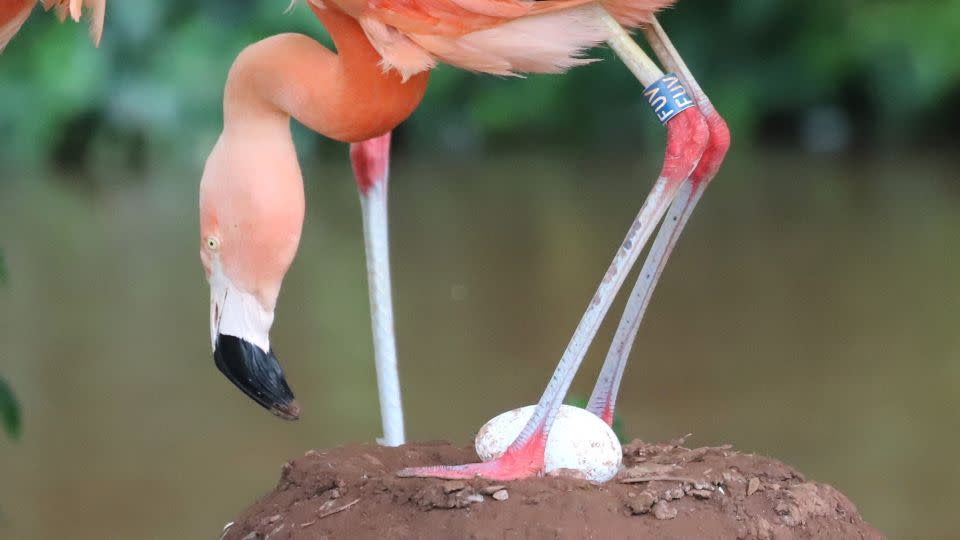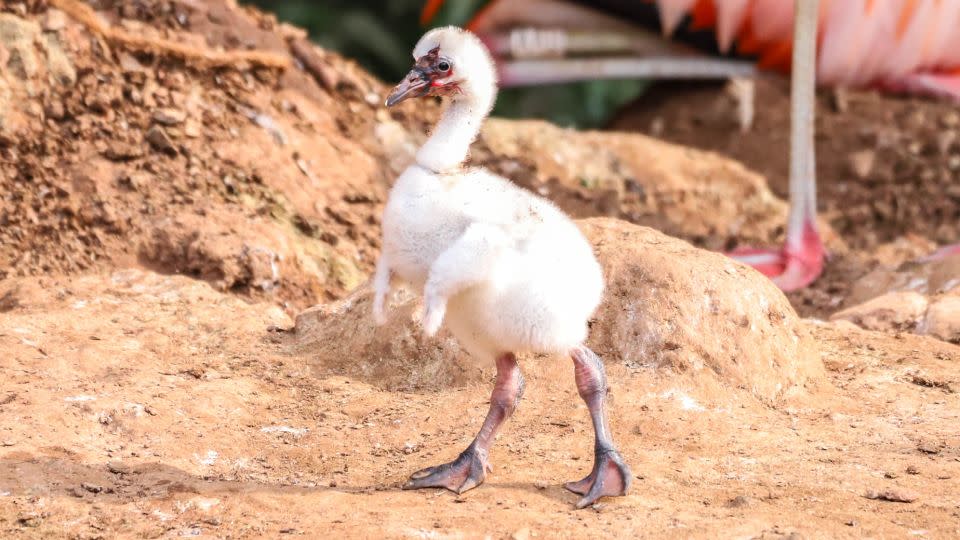Sign up for CNN’s Wonder Theory science newsletter. Explore the universe with news about fascinating discoveries, scientific developments and more.
Seven fluffy white Chilean flamingo chicks have appeared at a zoo in southwest England for the first time since 2018 — and one of them is particularly striking for the way it made its entrance. Two male flamingos named Arthur and Curtis have successfully hatched an egg together — a first for Paignton Zoo.
The zoo has had several all-male matings in the past, so the homosexual pairing is not an unexpected turn of events, said Pete Smallbones, the zoo’s curator of birds. But the zoo is not sure exactly how the pair obtained the egg.
“It’s likely that this egg became available — unprotected, just left (in a nest) — and they took it,” said Pete Smallbones, the zoo’s curator of birds. “As an avian department, we’re very aware that it’s a well-known thing for flamingos, penguins and other species to have same-sex pairings. So it wasn’t a shock — I think it was a little bit of a surprise just because it wasn’t quite the expected (male and female pairing).”
During the breeding season, pairs tend to spend more time together and follow each other around the enclosure, but a pairing is confirmed when two birds choose a nest to share, taking turns sitting on the mud mound with or without an egg. This year, however, one same-sex pair had an egg to sit on. Although two male birds incubating an egg together is remarkably rare, it has happened a handful of times in other zoos.
The successful hatching of the eggs between two males highlights the social birds’ innate parental instincts and adaptability, experts say. It also underscores the need for a conversation about the near-threatened Chilean flamingos, which are declining in the wild and their native South American home, according to the zoo’s press release. And experts have a number of theories about how and why their pair came together.

Birds of the same species
Chilean flamingos can be finicky when it comes to breeding. In the wild, observations have shown the species not breeding for up to nine years, as the birds wait until the weather and environmental conditions are just right, Smallbones said. But even at the zoo, which has their favorite mud nests, they often don’t breed every year.
One year at Paignton Zoo, flamingo eggs that were laid a few weeks late had to be removed because the chicks were unlikely to thrive in the colder weather, Smallbones said. Concerns about bird flu disrupted another previous breeding season, when the birds were removed from their enclosure as a safety measure, he added.
Curtis and Arthur’s chick, which has not yet been named, is almost a month old and appears to be doing well, Smallbones said. “The parents are clearly doing great.” The chick was spotted exploring the exhibit with another chick of about the same age, but will return to Curtis and Arthur for food.
While the two males are the only same-sex pairing the zoo is aware of this breeding season, the zoo could potentially welcome more chicks this year as several eggs are still incubating, the press release said.


Urge to nest
A number of other zoos have observed same-sex pairings in certain bird species. There have even been several success stories of egg hatching, such as in 2007 when the Wildfowl & Wetlands Trust in Gloucestershire entrusted an abandoned egg to two male flamingos, and in 2018 when two male penguins at Sydney’s Sea Life Aquarium also became adoptive parents to a chick.
“It is relatively common for captive flamingos to live in same-sex pairs due to the small size of the group,” said Paul Rose, a biologist and senior lecturer in animal behaviour at the University of Exeter. “Actually hatching an egg is more unusual. These two male flamingos were probably keen to nest but were unable to attract a female, so the same urge to nest brought them together.”
Sometimes same-sex flamingo pairs have been observed to disturb other nests, such as Chilean flamingos that nest in a flock, in an attempt to obtain eggs for themselves, Rose said.
In the wild, Chilean flamingos can number in the hundreds during the breeding season, Rose said. Paignton Zoo currently has 26 female flamingos and 25 male flamingos in its exhibit, suggesting there are plenty of females for the males to mate with, Smallbones said. While more research is needed to determine why same-sex pairings occur, it’s possible that Arthur and Curtis found an egg from an untended male and female and took the opportunity to tend it, or they took over another pair’s nest, Smallbones said.
It takes two
Flamingos often have nonbreeding partnerships that consist of same-sex relationships, according to a June 2020 study led by Rose. The birds tend to be “very choosy about who they spend time with, and will actively seek out certain birds in a flock and avoid others,” Rose added in an email. “I’m not surprised that two male flamingos are successful in raising a chick given their social flexibility, but I don’t believe it would have been their first choice for a breeding partner.”
According to Rose, same-sex pairs are more common in captivity than in the wild. However, some species of albatross (a type of seabird) have more females than males in the population. Sometimes females will pair up to raise a single egg, or they will both lay eggs and care for them together, says Kevin McGowan, an ornithologist at the Cornell Lab of Ornithology.
Like flamingos, incubating an egg and caring for an albatross chick requires two dedicated parents. Incubating an egg takes up to 60 days (for flamingos, it’s about 28 days) and both parents must provide food for the chick.
“You can’t do it alone. So these birds have figured out how to make it work. It’s in their instincts to want to take care of an egg no matter what the circumstances,” McGowan said. For Arthur and Curtis, the strong natural instinct to brood was likely the driving force behind same-sex mating. “There’s a great desire to have children, and these two guys (Arthur and Curtis) have figured out how to do that,” McGowan added.
Research into the occurrence of same-sex pairings in the wild could provide more information about the potential adaptive benefits of the behavior, such as when a wild flamingo loses its mate but has an egg to tend to, Rose said. “This shows how resourceful animals can be when they’re pushed to do something at a certain time of year or season.”
For more CNN news and newsletters, create an account at CNN.com